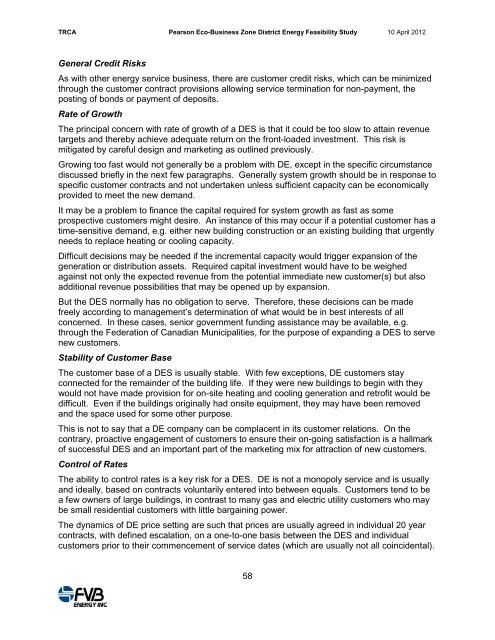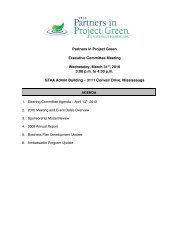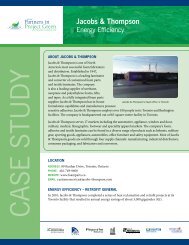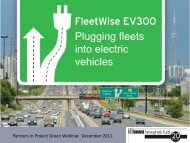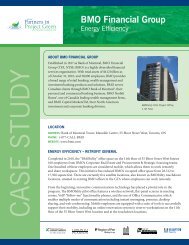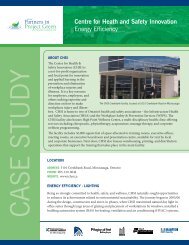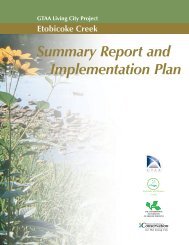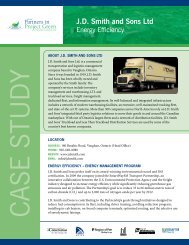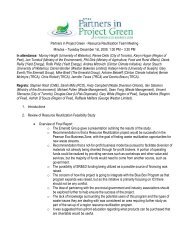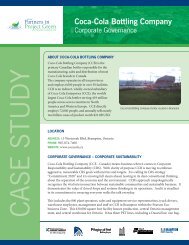Project Green District Energy Feasibility Study - Partners in Project ...
Project Green District Energy Feasibility Study - Partners in Project ...
Project Green District Energy Feasibility Study - Partners in Project ...
Create successful ePaper yourself
Turn your PDF publications into a flip-book with our unique Google optimized e-Paper software.
TRCA Pearson Eco-Bus<strong>in</strong>ess Zone <strong>District</strong> <strong>Energy</strong> <strong>Feasibility</strong> <strong>Study</strong> 10 April 2012<br />
General Credit Risks<br />
As with other energy service bus<strong>in</strong>ess, there are customer credit risks, which can be m<strong>in</strong>imized<br />
through the customer contract provisions allow<strong>in</strong>g service term<strong>in</strong>ation for non-payment, the<br />
post<strong>in</strong>g of bonds or payment of deposits.<br />
Rate of Growth<br />
The pr<strong>in</strong>cipal concern with rate of growth of a DES is that it could be too slow to atta<strong>in</strong> revenue<br />
targets and thereby achieve adequate return on the front-loaded <strong>in</strong>vestment. This risk is<br />
mitigated by careful design and market<strong>in</strong>g as outl<strong>in</strong>ed previously.<br />
Grow<strong>in</strong>g too fast would not generally be a problem with DE, except <strong>in</strong> the specific circumstance<br />
discussed briefly <strong>in</strong> the next few paragraphs. Generally system growth should be <strong>in</strong> response to<br />
specific customer contracts and not undertaken unless sufficient capacity can be economically<br />
provided to meet the new demand.<br />
It may be a problem to f<strong>in</strong>ance the capital required for system growth as fast as some<br />
prospective customers might desire. An <strong>in</strong>stance of this may occur if a potential customer has a<br />
time-sensitive demand, e.g. either new build<strong>in</strong>g construction or an exist<strong>in</strong>g build<strong>in</strong>g that urgently<br />
needs to replace heat<strong>in</strong>g or cool<strong>in</strong>g capacity.<br />
Difficult decisions may be needed if the <strong>in</strong>cremental capacity would trigger expansion of the<br />
generation or distribution assets. Required capital <strong>in</strong>vestment would have to be weighed<br />
aga<strong>in</strong>st not only the expected revenue from the potential immediate new customer(s) but also<br />
additional revenue possibilities that may be opened up by expansion.<br />
But the DES normally has no obligation to serve. Therefore, these decisions can be made<br />
freely accord<strong>in</strong>g to management’s determ<strong>in</strong>ation of what would be <strong>in</strong> best <strong>in</strong>terests of all<br />
concerned. In these cases, senior government fund<strong>in</strong>g assistance may be available, e.g.<br />
through the Federation of Canadian Municipalities, for the purpose of expand<strong>in</strong>g a DES to serve<br />
new customers.<br />
Stability of Customer Base<br />
The customer base of a DES is usually stable. With few exceptions, DE customers stay<br />
connected for the rema<strong>in</strong>der of the build<strong>in</strong>g life. If they were new build<strong>in</strong>gs to beg<strong>in</strong> with they<br />
would not have made provision for on-site heat<strong>in</strong>g and cool<strong>in</strong>g generation and retrofit would be<br />
difficult. Even if the build<strong>in</strong>gs orig<strong>in</strong>ally had onsite equipment, they may have been removed<br />
and the space used for some other purpose.<br />
This is not to say that a DE company can be complacent <strong>in</strong> its customer relations. On the<br />
contrary, proactive engagement of customers to ensure their on-go<strong>in</strong>g satisfaction is a hallmark<br />
of successful DES and an important part of the market<strong>in</strong>g mix for attraction of new customers.<br />
Control of Rates<br />
The ability to control rates is a key risk for a DES. DE is not a monopoly service and is usually<br />
and ideally, based on contracts voluntarily entered <strong>in</strong>to between equals. Customers tend to be<br />
a few owners of large build<strong>in</strong>gs, <strong>in</strong> contrast to many gas and electric utility customers who may<br />
be small residential customers with little barga<strong>in</strong><strong>in</strong>g power.<br />
The dynamics of DE price sett<strong>in</strong>g are such that prices are usually agreed <strong>in</strong> <strong>in</strong>dividual 20 year<br />
contracts, with def<strong>in</strong>ed escalation, on a one-to-one basis between the DES and <strong>in</strong>dividual<br />
customers prior to their commencement of service dates (which are usually not all co<strong>in</strong>cidental).<br />
58


